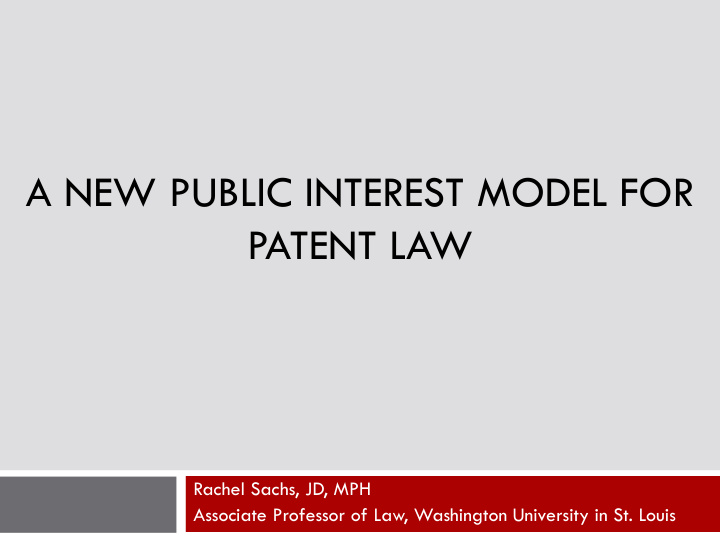



A NEW PUBLIC INTEREST MODEL FOR PATENT LAW Rachel Sachs, JD, MPH Associate Professor of Law, Washington University in St. Louis
A NEW PUBLIC INTEREST MODEL FOR INNOVATION POLICY Rachel Sachs, JD, MPH Associate Professor of Law, Washington University in St. Louis
Overview Doctrinal relevance: what areas of doctrine are implicated here, and what is missing from the analysis? Substantive content: what principles underlie a more robust public interest theory? Theoretical implications: what role would a more robust public interest theory play in patent theory?
Doctrinal Importance Explicit: permanent injunction standard (eBay) Implicit: patentable subject matter (LabCorp, Mayo, Myriad) Motivating the doctrine: compulsory licensing (Bayh- Dole march-in rights, section 1498)
Injunctions: Activated Sludge (1934) “Ordinarily courts will protect patent rights by injunctive process. … If, however, the injunction ordered by the trial court is made permanent in this case, it would close the sewage plant, leaving the entire community without any means for the disposal of raw sewage other than running it into Lake Michigan, thereby polluting its waters and endangering the health and lives of that and other adjoining communities. … [W]here, as here, the health and the lives of more than half a million people are involved, we think no risk should be taken.”
Injunctions: Amgen v. Sanofi (2017) “[E]liminating a choice of drugs is not, by itself, sufficient to disserve the public interest. Under such an approach, courts could never enjoin a drug because doing so would always reduce a choice of drugs. That, of course, is not the law. ... Just as a patent owner does not automatically receive an injunction merely by proving infringement, see eBay , an accused infringer cannot escape an injunction merely by producing infringing drugs. Accordingly, a reduction in choice of drugs cannot be the sole reason for a district court to deny an injunction.”
It’s Not Just The Drug. What happens if we take Sanofi’s drug off the market? Yes, patient loses choice of drug. But also: Switching costs for patients and insurers Amgen’s drug could become more expensive (list or net) Most importantly, Sanofi can’t complete the FDA-required clinical trials (Cue FDA/health law bat signal)
The Federal Circuit’s Analysis
Developing a Public Interest Framework Public health ethics analysis Population-based approach Enhance access – but not necessarily in the short-term, to the exclusion of the development of information Encourages technology development with particular focus on disadvantaged populations – but also must care about allocation of burdens Use of fair procedures and stakeholder consultations
A Role for Public Interest Theory Private law versus public law debates within patent law Reframing the mission of the FDA Broadening our view of the purpose of these areas of law allows for a rethinking of both court- and agency-level interactions
Questions? 11 September 2, 2019
Recommend
More recommend